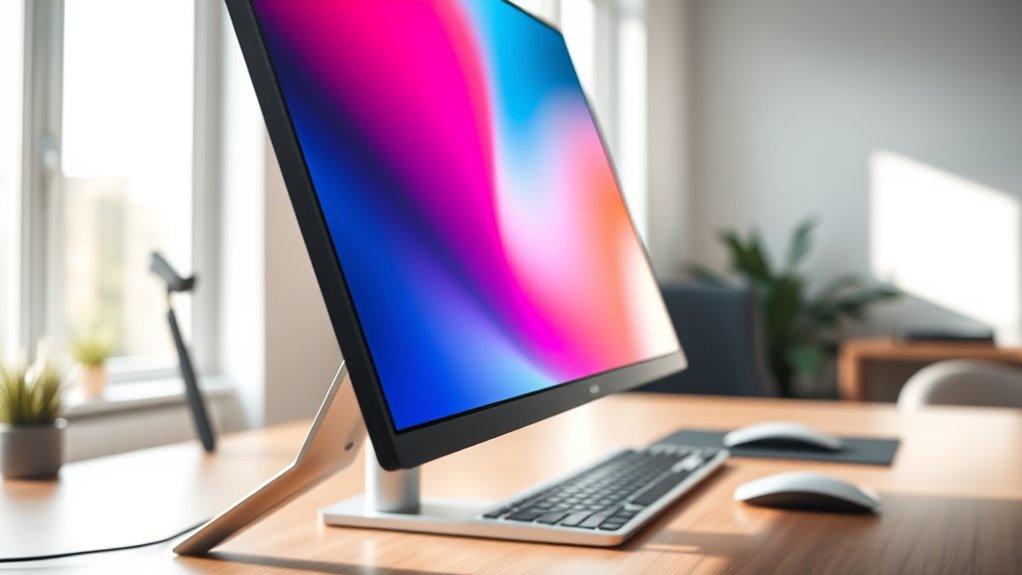To rotate your PC monitor, right-click on your desktop and select “Display settings.” In the “Scale and layout” section, choose your desired orientation—Landscape, Portrait, Landscape (flipped), or Portrait (flipped). You can also use keyboard shortcuts: Ctrl + Alt + Arrow keys to rotate the screen. If that doesn’t work, check your graphics driver settings. This quick adjustment can enhance your multitasking and viewing experience, and there’s more to discover about optimizing your display settings.
Understanding Screen Rotation Options
When you want to rotate your PC monitor, it is essential to understand the various screen rotation options available. Most operating systems provide multiple settings for screen rotation, allowing you to adjust the display preferences based on your needs. You can typically choose from standard orientations: landscape, portrait, reverse landscape, and reverse portrait. Each option offers unique advantages, especially when multitasking or working with specific applications. To access these settings, you’ll usually navigate through your display preferences menu. Keep in mind that some monitors may also have physical rotation capabilities, enhancing your flexibility. By mastering screen rotation, you create an environment tailored to your workflow, promoting both comfort and productivity.
Rotating Your Monitor on Windows
Rotating your monitor on Windows is straightforward, thanks to built-in features that allow for quick adjustments. To start, right-click on your desktop and select “Display settings.” Under the “Scale and layout” section, you’ll find an option for “Display orientation.” Choose between Landscape, Portrait, Landscape (flipped), and Portrait (flipped) as per your needs.
For an even faster approach, use keyboard shortcuts: pressing Ctrl + Alt + Arrow keys rotates your screen in the direction of the arrow. If these shortcuts aren’t working, you may need to enable them in your graphics driver’s monitor settings. With these methods, you’ll gain the freedom to customize your workspace effortlessly.
Adjusting Screen Orientation on Macos
Adjusting screen orientation on macOS is a simple process that enhances your viewing experience. You can change the screen rotation using the System Preferences, but mac shortcuts make it even easier. Here’s how you can quickly adjust the orientation:
- Open System Preferences: Click on the Apple menu and select “System Preferences.”
- Go to Displays: Click on “Displays,” then find the “Rotation” option.
- Choose your orientation: Select from Standard, 90°, 180°, or 270° to achieve your desired screen rotation.
For a faster approach, consider using mac shortcuts to toggle between orientations. This flexibility allows you to customize your setup, whether for productivity or entertainment, ensuring you have the freedom to view your content as you wish.
Changing Display Settings on Linux
Changing display settings on Linux can be accomplished through various methods, depending on your desktop environment. If you’re using GNOME, you can access the display configuration via the Settings menu. For KDE, navigate to System Settings and look for Display and Monitor options.
You can also utilize Linux commands in the terminal for more control. The `xrandr` command is particularly useful; it allows you to rotate your display with simple syntax like `xrandr –output [DISPLAY] –rotate left/right/inverted`.
Remember to replace `[DISPLAY]` with your actual display identifier. This method provides flexibility and is often preferred by users who value customization. With these tools at your disposal, you can easily adjust your display settings to fit your needs.
Troubleshooting Common Rotation Issues
When you encounter issues with monitor rotation, it can often stem from incorrect settings or software conflicts. Start by checking your graphic drivers; outdated drivers can lead to rotation problems. If your rotation shortcuts aren’t working, verify they’re enabled in your display settings.
Monitor rotation issues often arise from incorrect settings or outdated drivers; ensure your display settings are properly configured.
Here are some common troubleshooting steps:
- Update your graphic drivers: Visit the manufacturer’s website for the latest versions.
- Check display settings: Make sure the rotation option is set correctly for your desired orientation.
- Restart your system: Sometimes, a simple reboot can resolve conflicts or glitches.
Frequently Asked Questions
Can I Rotate My Monitor Physically Without Software Adjustments?
Yes, you can rotate your monitor physically without software adjustments, provided its design supports it. Many monitors feature adjustable stands, allowing for physical adjustments to orientation, enhancing your viewing experience without relying on software settings.
Will Rotating My Monitor Affect My Graphics Card Performance?
Rotating your monitor won’t release a cataclysmic performance impact on your graphics card. However, certain resolutions and orientations might slightly affect performance metrics, so keep an eye on your settings for best results.
How Do I Lock the Screen Orientation on My Monitor?
To lock your screen orientation, access the display settings in your operating system. Look for lock settings or orientation options, and select your preferred orientation. This prevents unwanted changes while allowing you to enjoy your setup freely.
Is There a Shortcut Key for Rotating the Screen on All Systems?
Isn’t it liberating to have control over your display? For screen rotation, try pressing Ctrl + Alt + Arrow keys; however, it may vary by system. Always check your settings if it doesn’t respond.
Can I Rotate Multiple Monitors Independently at the Same Time?
Yes, you can rotate multiple monitors independently in a multi-monitor setup. Most systems allow each display to have its own settings, letting you customize orientation based on your needs for flexibility and productivity.

